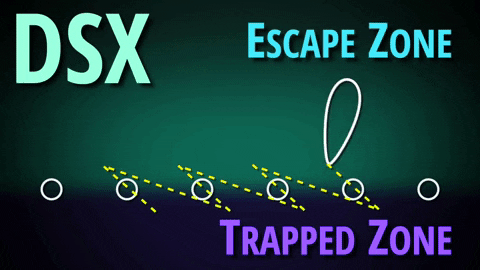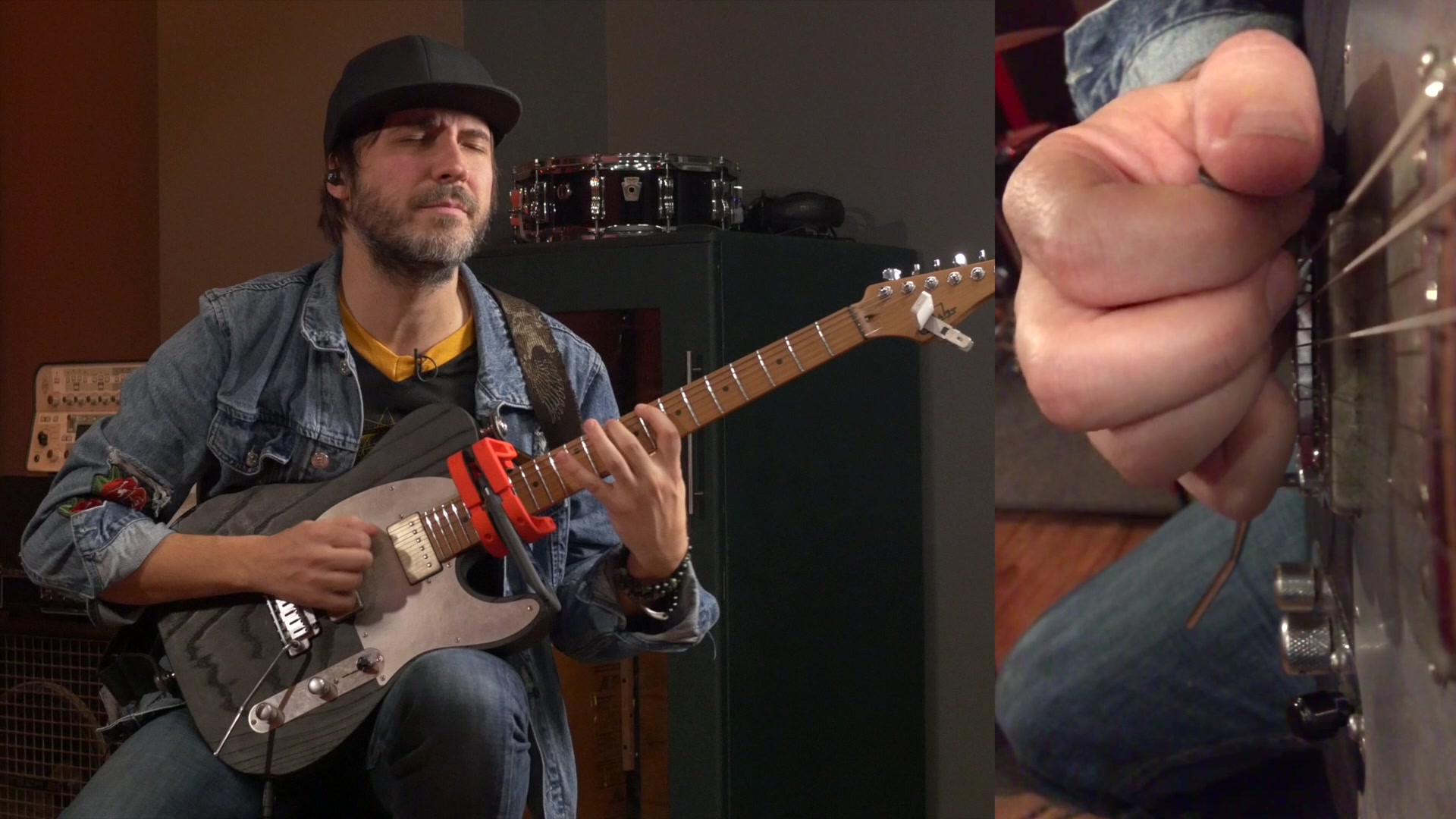DSX Motion
In a downstroke escape or DSX motion, the downstroke is the escape stroke and the upstroke is the trapped stroke.
This makes DSX motion the mechanical inverse of USX motion, tracing a diagonal path that appears to be tilted the in opposite direction:

To switch strings efficiently with DSX motion, the final note on every string needs to be a downstroke. Thanks to the angled trajectory of the motion path, downstrokes rise up in the air and escape the strings, letting you drop down to continue picking on a different string with no significant loss of efficiency:

This is the same string switching capability offered by USX motion, just with downstrokes instead of upstrokes. In fact, any phrase that can be played exclusively with USX motion can also be played exclusively with DSX motion by simply flipping the sequence of pickstrokes, so that new strings start on upstrokes and end on downstrokes, to capitalize on the escape.
Notable DSX users include fusion legends John McLaughlin and Al DiMeola, shred pioneer Michael Angelo Batio, and bluegrass and rock multi-instrumentalist Andy Wood. Here’s Andy playing a common six-note scale pattern in slow motion:
Each time Andy moves to a new string, the pick simply glides over the top of the trapping string without hitting it. In fact, if you watch closely, you can spot several instances where Andy’s upstrokes actually contact, or rest stroke, against the next string lower in pitch than the one he’s playing. This confirms that they are indeed still trapped, even though the downstrokes are escaped.
This is how we know Andy’s motion is actually following the characteristic diagonal trajectory of DSX motion, where downstrokes move up in the air and escape. This diagonal trajectory is hard to spot if you’re watching Andy from traditional audience perspective, but becomes visible when viewed more closely down the strings:

Bluegrass Speed
In bluegrass, DSX motion is a kind of de facto standard for fast playing on both guitar and mandolin. David Grier’s high-speed alternate picking technique is based on DSX wrist motion, and the pronounced trajectory of his escaped downstrokes is especially obvious when filmed from Magnet perspective:

In bluegrass repertoire, many traditional songs typically played at faster tempos also feature fretboard arrangements which are specficially optimized for this type of escape motion. In DSX-optimized arrangements, notes are strategically positioned across strings to maximize the number of downstroke string changes, and minimize the number of upstroke string changes.
In this segment of the fiddle tune Fisher’s Hornpipe, you can see the diagonal trajectory of Andy Wood’s DSX wrist motion, facilitating the string changes through escaped downstrokes on every string:

These conventions are all the more amazing considering their widespread propagation among the traditionally self-taught players who learn them. By focusing on motion smoothness at speed, players learn to discard phrases that would require the mechanically expensive process of switching between multiple joint motions. Over time, they build up improvisational vocabularies that can be played at high speed almost exclusively with a single type of escape motion — DSX — all without being conscious of doing so.
Shallow Escape
You may also notice that the escape trajectory of Andy’s DSX motion is shallow, and relatively close to parallel with the strings:

By contrast, Joscho Stephan’s Gypsy-style USX technique generates a more vertical escape angle, making its diagonal path more easily visible:

This shallowness in escape trajectory isn’t specific to DSX motion per se, but rather due to the different arm orientations and joint motions these two players use. Joscho’s technique uses a flexed wrist posture, with a mix of wrist joint and forearm joint motion. In both Joscho’s and Marty Friedman‘s techniques, this particular form and motion combination tends to pull the pick out of the strings more vertically.
But Andy uses mainly wrist motion with a form similar to Al Di Meola’s, which generates a shallower escape with less clearance during the string change. When viewed from the typical audience perspective, Andy and Al’s DSX wrist motion, along with the USX wrist motion of Mike Stern, all just appear to move side to side like a windshield wiper. The diagonal escape of these motions isn’t easily visible until you get up close with a camera, and even then only when you watch in slow motion.
When we watch Andy play the six-note pattern in regular speed video, the shallowness of the escape makes it much harder to notice:
As an example of just how much mechanical variety there exists in the world of picking motions, shred pioneer Michael Angelo Batio‘s famously clean lead technique uses a flexed wrist form reminiscent of the Gypsies, but actually generates a DSX pickstroke from that position:
Despite looking pretty different from the form used by wrist players like Andy, the result is a similarly shallow-escape DSX motion. Mike begins with the point of the pick below the D string, and from that position, the pick actually goes up, along a diagonal path that would take him right over the top of the G string if he kept going:
It’s not entirely clear which joints Mike is using to generate the motion, but the elbow appears to be at least one part of it. And the elbow is another joint that generates a shallow DSX motion. A textbook example of elbow DSX in action is Brendon Small‘s awesome technique. Seen here at normal speed, the pick’s motion above the strings is very hard to spot:
Wrist and elbow motion are both common choices among DSX players. And because these joints all move in a plane that’s almost parallel to the strings, the escape motions of many famous DSX wrist and elbow players, from John McLaughlin to Vinnie Moore, can all be hard to see without the kind of closeup Magnet view we’re using in these examples. This is one of the reasons why escape motion as a general concept went unnoticed for so many years, even by the players who actually use it.



